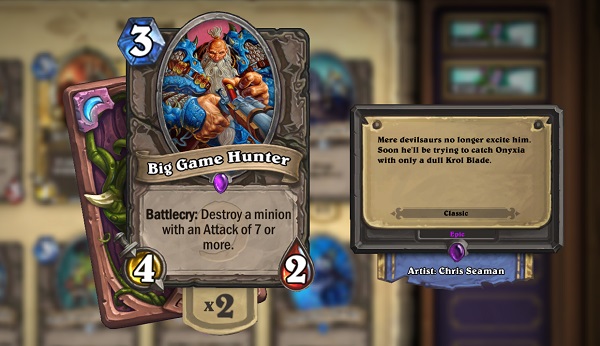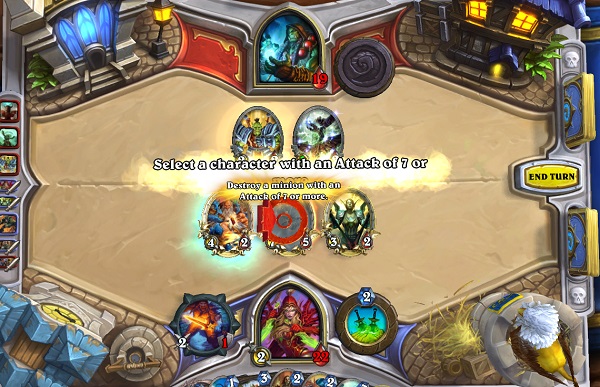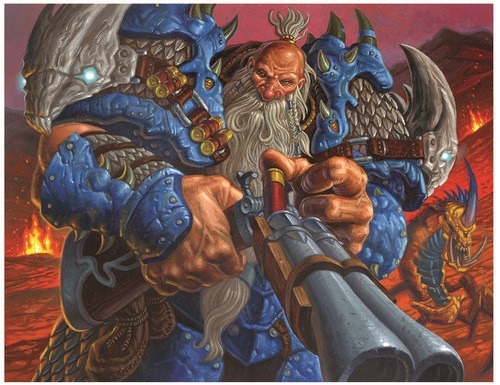The Power of Big Game Hunter in Hearthstone
With the release of The Grand Tournament, a lot of focus was placed by Blizzard to slow down the pace of the game. As the game has continued to grow, with hundreds of new cards to experiment with each year, a lot of cards and combos don’t see play because they take too long to develop. This is why The Grant Tournament had a focus with mechanics like ‘joust’ which aimed to reward slower paced decks by providing crucial heals and taunts to decent sized minions. A lot of decks which focus on the use of dragons, another slower paced deck, also received substantial buffs by providing the decks a ton of options for early game taunts which sought to control the aggro game.
Although aggro decks are still the most common archetype you see on the ladder, due to its relatively short duration of games which allows the player to rank up the fastest, Blizzard did quite a good job at allowing a lot of slower deck types to finally see some play. Yet when the meta slows down, the rise of one card in particular starts to creep back up making players see not just one, but two copies of a certain hunter that has his eyes set on the slow meta.

Big Game Hunter, apart from silences, is that one card that any player playing a slow deck hates to see. It’s the card that allows for a huge amount of tempo swing for the player that slams it down because it still leaves you with a decent chunk of mana left over to play a decently sized creature along with it. This is because although it’s a 3 mana cost card, it doesn’t typically see play until the later stages in the game. It’s not only destroying your large minion but it also provides a decent body (4 Attack/2 Health) as well as mana to spare for cards like Loatheb, Sludge Belcher, Piloted Shredder and other popular 4-5 mana cost inclusions. In decks like Warlock it can successfully kill the big minion in play as well as be a useful commodity for clearing any weaker minions your opponent might still have on the board by using himself with Shadowflame.

Not only this but with the card being an epic, and not legendary status, when the meta really begins to slow down and people start dropping the large minions, you begin to see two copies being tech choices in the majority of decks including aggro decks, to help combat those pesky giants. A lot of people have proposed ideas such as Hemet Nesingwary swapping his effect with Big Game Hunter so that it’s impossible for every class to have two ways to deal with big minions. This is another big issue with a card like Big Game Hunter. It provides certain classes with different strengths access to a card that provides powerful removal. Most late game cards with powerful effects tend to have more than 7 attack which means the likelihood of you getting use out of your Big Game Hunter is incredibly high when facing a control oriented deck. The only two cards that occasionally see play that avoid him are Chromaggus and Kel’Thuzad who require the player to typically be ahead before you even see these cards played on the board regardless.

The card is simply too powerful for what it provides the player. Before the nerf to Tinkermaster Overspark, which was used as a way to remove any powerful creatures with the potential for some setback (getting the 5/5 Devilsaur, whoops!), it was used in the majority of decks due to his value he provided classes like Druids who didn’t have access to hard removal like Shamans, Mages, or Warriors. However, with Blizzard’s policy of rarely changing the strength of a card it’s unlikely we see anything done to Hearthstone’s best legendary minion hunter. Yet if we see Blizzard continually look towards slowing down the pace of their game, maybe one day we’ll eventually see some kind of change to the card that always pokes his head out as the meta slows down.
Brandon Rendina